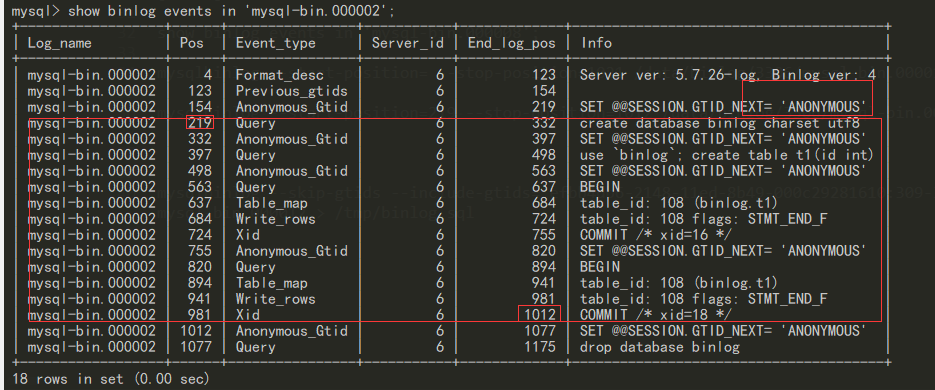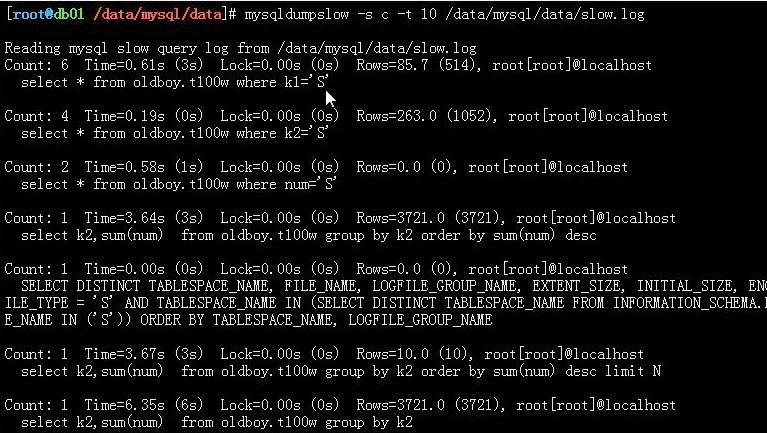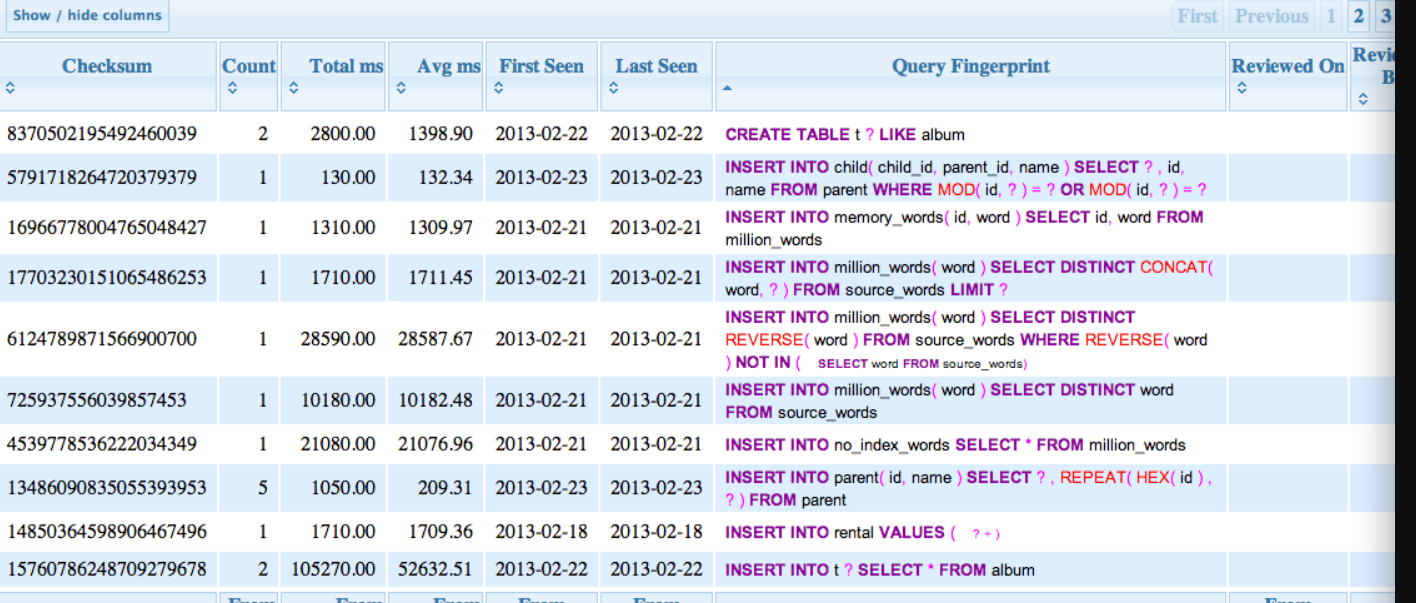错误日志(log_error)
--记录启动\关闭\日常运行过程中,状态信息,警告,错误
默认就是开启的: /数据路径下/hostname.err 手工设定: Master [(none)]>select @@log_error; vim /etc/my.cnf log_error=/var/log/mysql.log log_timestamps=system 重启生效 show variables like 'log_error';
默认位置:
DATADIR/hostname.err
配置方式
vim .etc/my.cnf
log_error=/data/mysql/data/mysql.log
查看:
mysql> select @@log_error; +----------------------+ | @@log_error | +----------------------+ | /data/3307/mysql.log | +----------------------+ 1 row in set (0.00 sec)
binlog(binary logs):二进制日志 *****
(1)备份恢复必须依赖二进制日志
(2)主从环境必须依赖二进制日志binlog配置 (5.7必须加server_id)
注意:MySQL默认是没有开启二进制日志的。 基础参数查看: 开关: [(none)]>select @@log_bin; 日志路径及名字 [(none)]>select @@log_bin_basename; 服务ID号: [(none)]>select @@server_id; 二进制日志格式: [(none)]>select @@binlog_format; 双一标准之二: [(none)]>select @@sync_binlog;
log_error=/data/mysql/data/mysql.log
log_bin=/data/binlog/3306/mysql-bin #/data/binlog/3306/ :目录 mysql-bin:文件名
[root@localhost 3306]# pwd /data/binlog/3306 [root@localhost 3306]# ll 总用量 8 -rw-r----- 1 mysql mysql 154 9月 4 13:51 mysql-bin.000001 -rw-r----- 1 mysql mysql 35 9月 4 13:51 mysql-bin.index
查看配置
mysql> show variables like '%log_bin%'; +---------------------------------+-----------------------------------+ | Variable_name | Value | +---------------------------------+-----------------------------------+ | log_bin | ON | | log_bin_basename | /data/binlog/3306/mysql-bin | | log_bin_index | /data/binlog/3306/mysql-bin.index | | log_bin_trust_function_creators | OFF | | log_bin_use_v1_row_events | OFF | | sql_log_bin | ON | +---------------------------------+-----------------------------------+ 6 rows in set (0.00 sec)
binlog记录了什么?
-----binlog是SQL层的功能。记录的是变更SQL语句,不记录查询语句。
记录SQL语句种类
DDL :原封不动的记录当前DDL(statement语句方式)。
DCL :原封不动的记录当前DCL(statement语句方式)。
DML :只记录已经提交的事务DMLDML三种记录方式binlog_format(binlog的记录格式)参数影响
(1)statement(5.6默认)SBR(statement based replication) :语句模式原封不动的记录当前DML。
(2)ROW(5.7 默认值) RBR(ROW based replication) :记录数据行的变化(用户看不懂,需要工具分析)
(3)mixed(混合)MBR(mixed based replication)模式 :以上两种模式的混合

mysql> show variables like 'bnlog_format'; +---------------+-------+ | Variable_name | Value | +---------------+-------+ | binlog_format | ROW | +---------------+-------+ 1 row in set (0.00 sec)
面试题
SBR与RBR模式的对比 STATEMENT:可读性较高,日志量少,但是不够严谨 ROW :可读性很低,日志量大,足够严谨 update t1 set xxx=xxx where id>1000 ? -->一共500w行,row模式怎么记录的日志 为什么row模式严谨? id name intime insert into t1 values(1,'zs',now()) 我们建议使用:row记录模式
event(事件)是什么?
事件的简介
二进制日志的最小记录单元
对于DDL,DCL,一个语句就是一个event
对于DML语句来讲:只记录已提交的事务。
例如以下列子,就被分为了4个event
begin; 120 - 340
DML1 340 - 460
DML2 460 - 550
commit; 550 - 760
event的组成
三部分构成:
(1) 事件的开始标识
(2) 事件内容
(3) 事件的结束标识
Position:
开始标识: at 194
结束标识: end_log_pos 254
194? 254?
某个事件在binlog中的相对位置号
位置号的作用是什么?
为了方便我们截取事件
查看一共多少个binlog
Master [(none)]>show binary logs; +------------------+-----------+ | Log_name | File_size | +------------------+-----------+ | mysql-bin.000001 | 154 | +------------------+-----------+ 1 row in set (0.01 sec) Master [(none)]>flush logs; Query OK, 0 rows affected (0.03 sec) Master [(none)]>flush logs; Query OK, 0 rows affected (0.01 sec) Master [(none)]>show binary logs; +------------------+-----------+ | Log_name | File_size | +------------------+-----------+ | mysql-bin.000001 | 201 | | mysql-bin.000002 | 201 | | mysql-bin.000003 | 154 | +------------------+-----------+ 3 rows in set (0.00 sec) Master [(none)]>
通过执行flush logs命令之后,再次查询binary log信息,发现已经使用了一个新的bin log文件了。
flush logs命令的作用就是关闭当前使用的binary log,然后打开一个新的binary log文件,binlog文件的序号递增加1
查看mysql正在使用的日志文件
Master [(none)]>show master status; +------------------+----------+--------------+------------------+-------------------+ | File | Position | Binlog_Do_DB | Binlog_Ignore_DB | Executed_Gtid_Set | +------------------+----------+--------------+------------------+-------------------+ | mysql-bin.000003 | 154 | | | | +------------------+----------+--------------+------------------+-------------------+ Master [(none)]>
file:当前MySQL正在使用的文件名
Position:最后一个事件的结束位置号
日志内容查看
event查看
Master [binlog]>show binlog events in 'mysql-bin.000003'; +------------------+-----+----------------+-----------+-------------+----------------------------------------+ | Log_name | Pos | Event_type | Server_id | End_log_pos | Info | +------------------+-----+----------------+-----------+-------------+----------------------------------------+ | mysql-bin.000003 | 4 | Format_desc | 6 | 123 | Server ver: 5.7.20-log, Binlog ver: 4 | | mysql-bin.000003 | 123 | Previous_gtids | 6 | 154 | | | mysql-bin.000003 | 154 | Anonymous_Gtid | 6 | 219 | SET @@SESSION.GTID_NEXT= 'ANONYMOUS' | | mysql-bin.000003 | 219 | Query | 6 | 319 | create database binlog | | mysql-bin.000003 | 319 | Anonymous_Gtid | 6 | 384 | SET @@SESSION.GTID_NEXT= 'ANONYMOUS' | | mysql-bin.000003 | 384 | Query | 6 | 486 | use `binlog`; create table t1 (id int) | +------------------+-----+----------------+-----------+-------------+----------------------------------------+ Log_name:binlog文件名 Pos:开始的position ***** Event_type:事件类型 Format_desc:格式描述,每一个日志文件的第一个事件,多用户没有意义,MySQL识别binlog必要信息 Server_id:mysql服务号标识 End_log_pos:事件的结束位置号 ***** Info:事件内容***** 补充: SHOW BINLOG EVENTS [IN 'log_name'] [FROM pos] [LIMIT [offset,] row_count] [root@db01 binlog]# mysql -e "show binlog events in 'mysql-bin.000004'" |grep drop
binlog文件内容详细查看
mysqlbinlog /data/mysql/mysql-bin.000006 mysqlbinlog --base64-output=decode-rows -vvv /data/binlog/mysql-bin.000003 mysqlbinlog -d binlog /data/binlog/mysql-bin.000003 [root@db01 binlog]# mysqlbinlog --start-datetime='2019-05-06 17:00:00' --stop-datetime='2019-05-06 17:01:00' /data/binlog/mysql-bin.000004
基于Position号进行日志截取
核心就是找截取的起点和终点 --start-position=321 --stop-position=513 mysqlbinlog --start-position=219 --stop-position=1347 /data/binlog/mysql-bin.000003 >/tmp/bin.sql 案例: 使用binlog日志进行数据恢复 模拟: 1. [(none)]>create database binlog charset utf8; 2. [(none)]>use binlog; [binlog]>create table t1(id int); 3. [binlog]>insert into t1 values(1); [binlog]>commit; [binlog]>insert into t1 values(2); [binlog]>commit; [binlog]>insert into t1 values(3); [binlog]>commit; 4. [binlog]>drop database binlog; 恢复: [(none)]>show master status ; [(none)]>show binlog events in 'mysql-bin.000004'; [root@db01 binlog]# mysqlbinlog --start-position=1227 --stop-position=2342 /data/binlog/mysql-bin.000004 >/tmp/bin.sql [(none)]>set sql_Log_bin=0;#设为0后,在Master数据库上执行的语句临时都不记录binlog,退出窗口可以恢复 [(none)]>source /tmp/bin.sql
-----上述通过pos位置恢复 需要关闭gitd----
经过测试发现 开起来gitd,通过pos位置无法恢复数据


mysqlbinlog --start-position=219 --stop-position=1012 /data/binlog/3306/mysql-bin.000002 >/tmp/bin.sql
binlog日志的GTID新特性
GTID 介绍
5.6 版本新加的特性,5.7中做了加强
5.6 中不开启,没有这个功能.
5.7 中的GTID,即使不开也会有自动生成
SET @@SESSION.GTID_NEXT= 'ANONYMOUS'
GTID(Global Transaction ID)
是对于一个已提交事务的编号,并且是一个全局唯一的编号。
它的官方定义如下:GTID = source_id :transaction_id
7E11FA47-31CA-19E1-9E56-C43AA21293967:29
重要参数介绍:
vim /etc/my.cnf gtid-mode=on enforce-gtid-consistency=true systemctl restart mysqld Master [(none)]>create database gtid charset utf8; Query OK, 1 row affected (0.01 sec) Master [(none)]>show master status ; +------------------+----------+--------------+------------------+----------------------------------------+ | File | Position | Binlog_Do_DB | Binlog_Ignore_DB | Executed_Gtid_Set | +------------------+----------+--------------+------------------+----------------------------------------+ | mysql-bin.000004 | 326 | | | dff98809-55c3-11e9-a58b-000c2928f5dd:1 | +------------------+----------+--------------+------------------+----------------------------------------+ 1 row in set (0.00 sec) Master [(none)]>use gtid Database changed Master [gtid]>create table t1 (id int); Query OK, 0 rows affected (0.01 sec) Master [gtid]>show master status ; +------------------+----------+--------------+------------------+------------------------------------------+ | File | Position | Binlog_Do_DB | Binlog_Ignore_DB | Executed_Gtid_Set | +------------------+----------+--------------+------------------+------------------------------------------+ | mysql-bin.000004 | 489 | | | dff98809-55c3-11e9-a58b-000c2928f5dd:1-2 | +------------------+----------+--------------+------------------+------------------------------------------+ 1 row in set (0.00 sec) Master [gtid]>create table t2 (id int); Query OK, 0 rows affected (0.01 sec) Master [gtid]>create table t3 (id int); Query OK, 0 rows affected (0.02 sec) Master [gtid]>show master status ; +------------------+----------+--------------+------------------+------------------------------------------+ | File | Position | Binlog_Do_DB | Binlog_Ignore_DB | Executed_Gtid_Set | +------------------+----------+--------------+------------------+------------------------------------------+ | mysql-bin.000004 | 815 | | | dff98809-55c3-11e9-a58b-000c2928f5dd:1-4 | +------------------+----------+--------------+------------------+------------------------------------------+ 1 row in set (0.00 sec) Master [gtid]>begin; Query OK, 0 rows affected (0.00 sec) Master [gtid]>insert into t1 values(1); Query OK, 1 row affected (0.00 sec) Master [gtid]>commit; Query OK, 0 rows affected (0.00 sec) Master [gtid]>show master status ; +------------------+----------+--------------+------------------+------------------------------------------+ | File | Position | Binlog_Do_DB | Binlog_Ignore_DB | Executed_Gtid_Set | +------------------+----------+--------------+------------------+------------------------------------------+ | mysql-bin.000004 | 1068 | | | dff98809-55c3-11e9-a58b-000c2928f5dd:1-5 | +------------------+----------+--------------+------------------+------------------------------------------+ 1 row in set (0.00 sec) Master [gtid]>begin; Query OK, 0 rows affected (0.00 sec) Master [gtid]>insert into t2 values(1); Query OK, 1 row affected (0.00 sec) Master [gtid]>commit; Query OK, 0 rows affected (0.01 sec) Master [gtid]>show master status ; +------------------+----------+--------------+------------------+------------------------------------------+ | File | Position | Binlog_Do_DB | Binlog_Ignore_DB | Executed_Gtid_Set | +------------------+----------+--------------+------------------+------------------------------------------+ | mysql-bin.000004 | 1321 | | | dff98809-55c3-11e9-a58b-000c2928f5dd:1-6 | +------------------+----------+--------------+------------------+------------------------------------------+ 1 row in set (0.00 sec)
基于GTID进行查看binlog
具备GTID后,截取查看某些事务日志: --include-gtids --exclude-gtids mysqlbinlog --include-gtids='dff98809-55c3-11e9-a58b-000c2928f5dd:1-6' --exclude-gtids='dff98809-55c3-11e9-a58b-000c2928f5dd:4' /data/binlog/mysql-bin.000004 跳过多个事务id mysqlbinlog --include-gtids='dff98809-55c3-11e9-a58b-000c2928f5dd:1-6' --exclude-gtids='dff98809-55c3-11e9-a58b-000c2928f5dd:4,dff98809-55c3-11e9-a58b-000c2928f5dd:5' /data/binlog/mysql-bin.000004
GTID的幂等性
开启GTID后,MySQL恢复Binlog时,重复GTID的事务不会再执行了 就想恢复?怎么办? --skip-gtids mysqlbinlog --skip-gtids --include-gtids='3ca79ab5-3e4d-11e9-a709-000c293b577e:4' /data/binlog/mysql-bin.000004 > /tmp/binlog.sql set sql_log_bin=0; source /tmp/binlog.sql set sql_log_bin=1;
--skip-gtids=xxx的作用为:mysqldump 是否使用--skip-gtids=true 参数,要根据情况来定; 第一种情况: 如果我们是要恢复数据到源数据库或者和源数据库有相同 GTID 信息的实例,那么就要使用该参数。如果不带该参数的话,是无法恢复成功的。因为包含的 GTID 已经在源数据库执行过了,根据 GTID 特性,一个 GTID 信息在一个数据库只能执行一次,
所以不会恢复成功。 第二种情况: 如果是恢复到其他实例的数据库并且不包含源实例的 GTID 信息,那么可以不使用该参数,使用或者不使用都可以恢复成功。
使用二进制日志恢复数据案例
故障环境介绍
创建了一个库 db, 导入了表t1 ,t1表中录入了很多数据 一个开发人员,drop database db; 没有备份,日志都在.怎么恢复? 思路:找到建库语句到删库之前所有的日志,进行恢复.(开启了GTID模式) 故障案例模拟: (0) drop database if exists db ; (1) create database db charset utf8; (2) use db; (3) create table t1 (id int); (4) insert into t1 values(1),(2),(3); (5) insert into t1 values(4),(5),(6); (6) commit (7) update t1 set id=30 where id=3; (8) commit; (9) delete from t1 where id=4; (10)commit; (11)insert into t1 values(7),(8),(9); (12)commit; (13)drop database db; ======================== drop database if exists db ; create database db charset utf8; use db; create table t1 (id int); insert into t1 values(1),(2),(3); insert into t1 values(4),(5),(6); commit; update t1 set id=30 where id=3; commit; delete from t1 where id=4; commit; insert into t1 values(7),(8),(9); commit; drop database db; ======= 运行以上语句,模拟故障场景 需求:将数据库恢复到以下状态(提示第9步和第13步是误操作,其他都是正常操作)
恢复过程(无GTID时的恢复)
1,查看当前使用的 binlog文件
oldguo [db]>show master status ; +------------------+----------+--------------+------------------+-------------------+ | File | Position | Binlog_Do_DB | Binlog_Ignore_DB | Executed_Gtid_Set | +------------------+----------+--------------+------------------+-------------------+ | mysql-bin.000006 | 1873 | | | | +------------------+----------+--------------+------------------+-------------------+ 2.查看事件: 第一段: | mysql-bin.000006 | 813 | Query | 1 | 907 | use `db`; create table t1 (id int) | | mysql-bin.000006 | 907 | Query | 1 | 977 | BEGIN | | mysql-bin.000006 | 977 | Table_map | 1 | 1020 | table_id: 77 (db.t1) | | mysql-bin.000006 | 1020 | Write_rows | 1 | 1070 | table_id: 77 flags: STMT_END_F | | mysql-bin.000006 | 1070 | Table_map | 1 | 1113 | table_id: 77 (db.t1) | | mysql-bin.000006 | 1113 | Write_rows | 1 | 1163 | table_id: 77 flags: STMT_END_F | | mysql-bin.000006 | 1163 | Xid | 1 | 1194 | COMMIT /* xid=74 */ | | mysql-bin.000006 | 1194 | Query | 1 | 1264 | BEGIN | | mysql-bin.000006 | 1264 | Table_map | 1 | 1307 | table_id: 77 (db.t1) | | mysql-bin.000006 | 1307 | Update_rows | 1 | 1353 | table_id: 77 flags: STMT_END_F | | mysql-bin.000006 | 1353 | Xid | 1 | 1384 | COMMIT /* xid=77 */ mysqlbinlog --start-position=813 --stop-position=1384 /data/mysql/mysql-bin.000006 >/tmp/bin1.sql
第二段:
| mysql-bin.000006 | 1568 | Query | 1 | 1638 | BEGIN | | mysql-bin.000006 | 1638 | Table_map | 1 | 1681 | table_id: 77 (db.t1) | | mysql-bin.000006 | 1681 | Write_rows | 1 | 1731 | table_id: 77 flags: STMT_END_F | | mysql-bin.000006 | 1731 | Xid | 1 | 1762 | COMMIT /* xid=81 */ mysqlbinlog --start-position=1568 --stop-position=1762 /data/mysql/mysql-bin.000006 >/tmp/bin2.sql
3,恢复
set sql_log_bin=0; source /tmp/bin1.sql source /tmp/bin2.sql set sql_log_bin=1; oldguo [db]>select * from t1; +------+ | id | +------+ | 1 | | 2 | | 30 | | 4 | | 5 | | 6 | | 7 | | 8 | | 9 |
有GTID的恢复:
mysqlbinlog --skip-gtids --include-gtids='3ca79ab5-3e4d-11e9-a709-000c293b577e:7-12' mysql-bin.000004> /tmp/bin.sql
恢复
set sql_log_bin=0; source /tmp/bin.sql
二进制日志其他操作
自动清理日志
show variables like '%expire%'; expire_logs_days 0 自动清理时间,是要按照全备周期+1 set global expire_logs_days=8; 永久生效:修改配置文件 vim my.cnf expire_logs_days=15; 企业建议,至少保留两个全备周期+1的binlog
手工清理(危险)
PURGE BINARY LOGS BEFORE now() - INTERVAL 3 day; PURGE BINARY LOGS TO 'mysql-bin.000010'; 注意:不要手工 rm binlog文件 1. my.cnf binlog关闭掉,启动数据库 2.把数据库关闭,开启binlog,启动数据库 删除所有binlog,并从000001开始重新记录日志
reset master; 主从关系中,主库执行此操作,主从环境必崩
日志是怎么滚动
flush logs; 重启mysql也会自动滚动一个新的 日志文件达到1G大小(max_binlog_size) | max_binlog_size | 1073741824 备份时,加入参数也可以自动滚动
slow_log 慢日志
记录慢SQL语句的日志,定位低效SQL语句的工具日志
mysql> show variables like '%slow%'; +---------------------------+-------------------------------------+ | Variable_name | Value | +---------------------------+-------------------------------------+ | log_slow_admin_statements | OFF | | log_slow_slave_statements | OFF | | slow_launch_time | 2 | | slow_query_log | ON | | slow_query_log_file | /data/mysql/data/localhost-slow.log | +---------------------------+-------------------------------------+ 5 rows in set (0.00 sec)
开启慢日志(默认没开启)
开关: slow_query_log=1 文件位置及名字 slow_query_log_file=/data/mysql/slow.log 设定慢查询时间: long_query_time=0.1 没走索引的语句也记录: log_queries_not_using_indexes #不走索引 vim /etc/my.cnf slow_query_log=1 slow_query_log_file=/data/mysql/slow.log long_query_time=0.1 log_queries_not_using_indexes systemctl restart mysqld
mysqldumpslow 分析慢日志
mysqldumpslow -s c -t 10 /data/mysql/slow.log # 第三方工具(自己扩展) https://www.percona.com/downloads/percona-toolkit/LATEST/ yum install perl-DBI perl-DBD-MySQL perl-Time-HiRes perl-IO-Socket-SSL perl-Digest-MD5 toolkit工具包中的命令: ./pt-query-diagest /data/mysql/slow.log Anemometer基于pt-query-digest将MySQL慢查询可视化

常用的参数
-s:是表示按照何种方式排序
| 参数值 | 说明 |
|---|---|
| c | 访问计数 |
| l | 锁定时间 |
| r | 返回记录 |
| t | 查询时间 |
| al | 平均锁定时间 |
| ar | 平均返回记录数 |
| at | 平均查询时间 |
-t:是top n的意思,即为返回前面多少条的数据
-g:后边可以写一个正则匹配模式,大小写不敏感的
Mysql慢查询日志分析及percona-toolkit的使用
相关文献:
https://blog.csdn.net/qq_41600067/article/details/112952251
https://naibawu.com/1250.html
https://www.cnblogs.com/yaomaomao/p/12672283.html

本文来自博客园,作者:孙龙-程序员,转载请注明原文链接:https://www.cnblogs.com/sunlong88/p/16655005.html






【推荐】国内首个AI IDE,深度理解中文开发场景,立即下载体验Trae
【推荐】编程新体验,更懂你的AI,立即体验豆包MarsCode编程助手
【推荐】抖音旗下AI助手豆包,你的智能百科全书,全免费不限次数
【推荐】轻量又高性能的 SSH 工具 IShell:AI 加持,快人一步
· 没有Manus邀请码?试试免邀请码的MGX或者开源的OpenManus吧
· 无需6万激活码!GitHub神秘组织3小时极速复刻Manus,手把手教你使用OpenManus搭建本
· C#/.NET/.NET Core优秀项目和框架2025年2月简报
· DeepSeek在M芯片Mac上本地化部署
· 葡萄城 AI 搜索升级:DeepSeek 加持,客户体验更智能